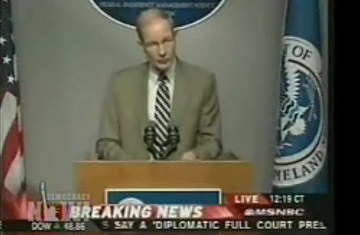
FEMA held a press conference on Oct. 23 to respond to fake questions about the real wildfires in California. Here's how it happened: Real reporters were notified only 15 minutes in advance, so all they could reasonably do was call in to a conference line. But the line was set to "listen-only" mode, so asking questions was out of the question. Only the people there — a group consisting almost entirely of FEMA public affairs employees — could grill FEMA representatives.
None of this was disclosed by Vice Adm. Harvey E. Johnson, the deputy administrator of FEMA, who dutifully responded to the softballs from his underlings (i.e. "Are you happy with FEMA's response so far?") as if they were real.
To his credit, Homeland Security Secretary Michael Chertoff lambasted FEMA after the story broke in the Washington Post several days later. "I think it was one of the dumbest and most inappropriate things I've seen since I've been in government," Chertoff said. "I have made unambiguously clear, in Anglo-Saxon prose, that it is not to ever happen again and there will be appropriate disciplinary action taken against those people who exhibited what I regard as extraordinarily poor judgment."
But here's the irony: in a way, FEMA had responded as it had trained to respond. Since 2000, the nation has held four full-scale exercises to simulate a major terrorist attack. Each time, the "mock media" is played by fake reporters — paid PR people, to be specific — just like in the fake FEMA press conference last week.
Since 2003, Ogilvy PR, an international firm which also works for Disney and Slim-Fast, has been paid by the government to hold fake press conferences and broadcast live to a Virtual News Network (VNN), a closed-circuit satellite TV network modeled after CNN. Only people involved in the exercise can watch VNN or access its web site. The real media are only allowed to watch from afar.
Two weeks ago, for example, the feds held their last major exercise — simulating dirty bomb attacks in Portland, Phoenix and Guam. A VNN anchor played by former TV journalist Forrest Sawyer broke the "news." A real reporter from the Portland Tribune noted that he and the rest of the actual media were kept more than a football field away from the scene.
Before the simulation, I asked FEMA why they weren't using real reporters instead. I was told that the material was too sensitive, for one thing, and for another, real reporters would change the dynamic of what was intended to be a learning atmosphere.
But FEMA's decision last week to exclude real reporters from a matter of real national security — in which half a million people had been evacuated from their homes due to uncontrolled fire — would suggest that the best way to provide an atmosphere of learning would be to include real reporters before the disaster strikes. Maybe if FEMA had established good relationships with more real reporters before the wildfires, the agency would feel confident enough to allow them to ask questions during press conferences.
For now, Chertoff has ordered Russ Knocke, his own lead press secretary for DHS, to go over and "assist" at FEMA. Knocke starts his new temporary job on Oct. 29. When I asked him if this whole fiasco was yet another reminder that it might be better to include real reporters in fake disasters (and not the other way around), he said, "I do recognize your perspective that there's more that we can do to increase transparency when it comes to those kinds of exercises. That point is noted. Though right now my priority is on real-world ability — to be sure that FEMA public affairs has the professionalism that everyone expects from the Secretary on down."
Hear that? That's the sound of real-world experience, the kind you get from dealing with real-world pains in the ass like me.
